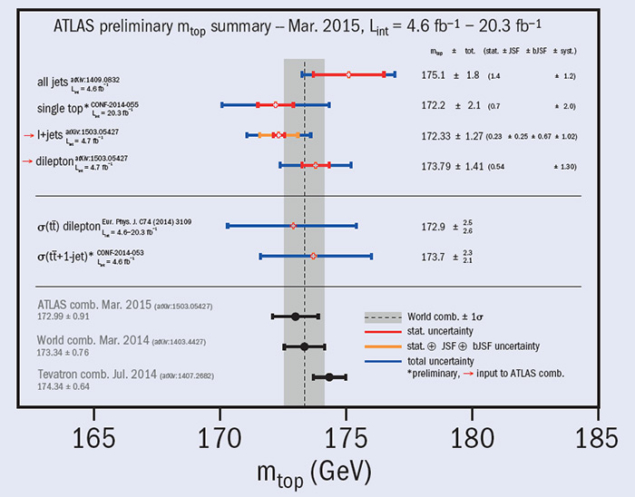
The top quark is the heaviest elementary particle known currently, and its mass (mtop) is a fundamental parameter of the Standard Model. Its precise determination is essential for testing the consistency of the Standard Model and to constrain models of new physics. Now, ATLAS has released new measurements of mtop using events with one or two isolated charged leptons and jets in the final state – the lepton+jets and dilepton channel. The new results are based on proton–proton collision data taken at a centre-of-mass-energy of 7 TeV.
The measurements were obtained from the direct reconstruction of the top-quark final states, and use calibrations based on Monte Carlo simulation. In the analysis, for the first time, the lepton+jets channel mtop is determined simultaneously with a global jet-energy scale factor, thus exploiting information from the hadronically decaying W boson and a separate b-to-light-quark jet-energy scale factor – a technique that reduces the corresponding systematic uncertainties on mtop significantly. The measurement in the dilepton channel is based on the invariant mass of the two charged-lepton and b-quark-jet systems from top-quark-pair decays. The measurements in the two channels are largely uncorrelated, which allows their combination to yield a substantial improvement in precision. The result, mtop = 172.99±0.91 GeV, corresponds to a relative uncertainty of 0.5% (ATLAS 2015a).
These new measurements, together with the results from the fully hadronic decay channel (ATLAS 2015b), complete the suite of mtop results based on 7-TeV data that exploit top-quark-pair signatures. They are complemented by a result based on single-top-quark-enriched topologies, using 8-TeV data (ATLAS 2014a).
In the direct mass-reconstruction techniques described above, the extracted value of mtop corresponds to the parameter implemented in the Monte Carlo (mMCtop) whose relationship with the top-mass parameter in the Standard Model Lagrangian is not completely clear. The uncertainty relating the top mass in the Standard Model to mMCtop is a matter of debate, but is often estimated to be about 1 GeV, which is comparable to the present experimental precision.
ATLAS follows complementary paths to measure mtop by comparing the measurements of cross-sections for inclusive and differential top-quark-pair production with the corresponding theoretical calculations, which depend on the top-quark-pole mass mpoletop. To date, the most precise mpoletop determination is obtained from the differential cross-section measurements of top-quark-pair events with one additional jet. Using 7-TeV data, the measurement yields mpoletop = 173.7+2.3–2.1 GeV (ATLAS 2014b), which is compatible to the results from the direct reconstruction of the top-quark decays. The figure shows the ATLAS results for mtop, together with results from the Tevatron and the world average.
Upcoming results exploiting the full 8-TeV data seta, and data from LHC Run 2, will further improve understanding of the mass of the top quark and its theoretical interpretation.





